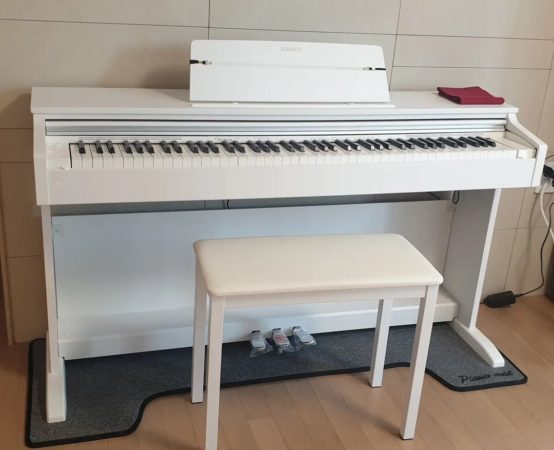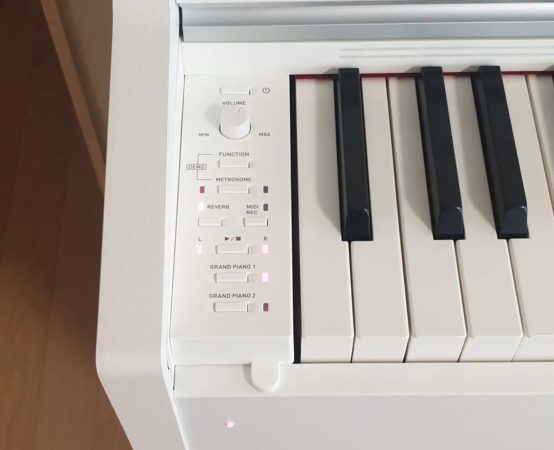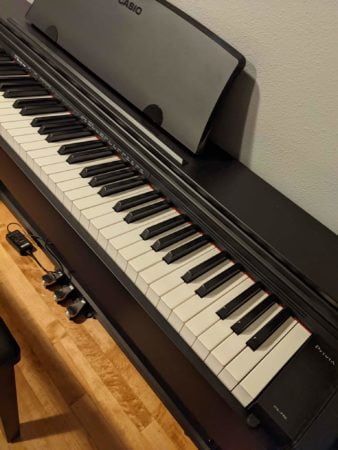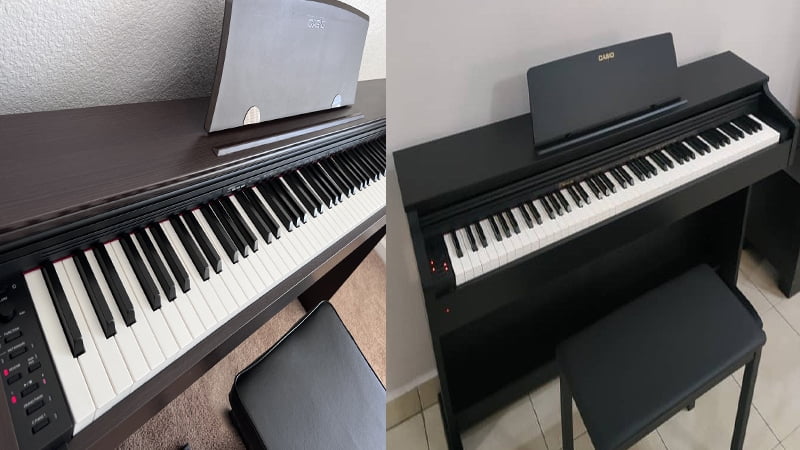Find out which model is a better fit for you in this Casio PX-770 vs AP-270 review and comparison!
It can be hard to compare two digital pianos. However, since these two models are made by the same company, it was a bit easier to compare. And by the end of the Casio PX-770 vs AP-270 comparison, I found that the Casio AP-270 was the winner.
With that said, the battle was very close since the Casio PX-770 remains to be one of the best digital console pianos in its price range. But despite it’s incredibly realistic feel and great tone generation, the PX-770 couldn’t hold up against the wider sound library and higher polyphony of the AP-270.
And while I found the Casio AP-270 to be the superior option, any pianist out there will enjoy using either of these pianos. But at the end of it all, the slight advantage of the AP-270 in terms of versatility gave it the slightest edge over the competition.
Casio PX-770 vs AP-270: Comparison Chart




Last update on 2025-04-07 / Affiliate links / Images from Amazon Product Advertising API
Casio PX-770 vs AP-270: The Features
When comparing each of these piano’s features up head to head, the final score was 3-1, in favor of the Casio AP-270. However, while the Casio AP-270 won out in terms of tone and piano features, you’ll soon learn that the fight was closer than you think. And in the end, I would recommend either the Casio PX-770 and AP-270 for any beginner.

Tone
The winner: Casio AP-270
Both of these pianos use the same tone generator. The sounds from these models come from the AiR sound source, which is why both pianos have a great set of piano voices. However, since the AP-270 had a slightly more varied sound library, I chose it as the winner in this comparison.
+Tone Generator
The AiR Sound Source is one of the primary features of any Casio model. If you’re shopping for a Casio digital piano and it uses the AiR Sound Source, you’re ensured of high-quality tones that will rival any other model in its price range.
The AiR Sound Source works by playing four different samples of the same sound. This results in a more realistic tone that sounds very close to the acoustic source of the sound. The technology developed by Casio allows the sound waves to travel through the air just like it would from an acoustic piano.
Paired with the great speakers on both of these pianos, the result is a beautiful and rich piano tone. While the tones aren’t exactly identical to an acoustic piano, all it takes is one listen to figure out the quality of these pianos.
So, if you’re looking for high-quality tones, you’ll be getting just that with either of these options.
+Sound Library
The reason the Casio AP-270 won out in terms of tone isn’t because of sound quality. In fact, both of these pianos have about the same score when it comes to sound quality. However, the difference maker was the sound library.
With the Casio AP-270, you get 22 different tones. With the Casio PX-770, you only get 19 different voices. While the difference is very miniman, if you’re looking for a more versatile and flexible instrument, the Casio AP-270 has a slight edge.
With that said, you still get the same voice categories with both pianos. They both sport and feature multiple options for electric and acoustic pianos, as well as a variety of organ, strings, and bass sounds.
But if you choose the Casio AP-270 you get a couple more options when it comes to the acoustic piano sounds. This gives you more versatility and allows you to fit in a wider variety of genres.
Again, the difference is minimal, but it’s still there. So, while you get a pretty wide set of voices with the Casio PX-770, you get a few more options with the Casio AP-270.
Piano Features
The winner: Casio AP-270
Both the Casio AP-270 and the PX-770 feature the same playing modes. These different modes allow you to use the pianos in different ways, which is a great feature for any beginner and novice pianist. However, with the Casio AP-270, you have better polyphony, which is why it won out in this category as well.
+Playing Modes

Both of these pianos feature the essential playing modes: duet (lesson), dual (layering), and split mode. While some pianos have additional playing modes, as a pianist, these are really the only modes you will absolutely need when playing and performing.
Duet mode is designed for piano lessons. With this mode engaged, you divide the piano into two mini keyboards. These keyboards will trigger the same sounds and have the same pitch and timbre. So, if you’re at piano lessons, the teacher will have an easier time demonstrating different techniques. On top of that, you can play along together as if you were playing on two different pianos.
With dual mode, you can layer two voices on top of each other, which is why it’s also called layering mode. So, you can create your own unique tone combinations. And since the Casio AP-270 has more built-in voices, there are more possibilities with dual mode on this piano compared to the PX-770.
Lastly, split mode is a great performance too. When using this mode, you can assign different voices to each side of the piano. For example, you can load strings voices on the left side and piano voices on the right side. This makes it seem like you’re playing two instruments at the same time and is a great feature for any performing pianist.
Additionally, you can also record your own playing on both these pianos. However, keep in mind that these are MIDI recordings. So, they aren’t designed for studio use. Instead, you can record yourself to listen back on your playing and figure out where you need to make adjustments.
+Polyphony
The Casio AP-270 has better polyphony than the PX-770. This isn’t exactly a major difference, but it is the reason the Casio AP-270 wins out in terms of piano features.
The Casio AP-270 has 192-note maximum polyphony while the PX-770 only has 128-note maximum polyphony. When using the standard playing mode, this doesn’t make a difference. With either of the pianos, you can still play dense and spread out chords, even with the sustain pedal engaged.
However, the difference is evident when using layering mode. This is because you trigger multiple samples at a time with layering mode. And since the Casio AP-270 can handle more notes at a time, layering mode works better on this model compared to the Casio PX-770.
Again, the difference is minimal. However, since these two pianos are very similar, it’s these small differences that set them apart in the end.
Feel
The winner: Tie
When testing out these pianos myself, I found no difference in terms of feel. That’s why I declared it a tie between these two models. So, regardless of the piano you choose, you get realistic hammer action and key texture that emulates an acoustic piano very well.
+Hammer Action
Both of these pianos utilize Casio’s scaled hammer action system. In simple terms, this hammer action replicates the weight of an acoustic piano. So, you will have heavier keys on the left side compared to the right side.
Whether you’re a beginner or advanced pianist, this is a very important feature. You need to get a digital piano that emulates the feel of an acoustic piano so that you can train your muscles to handle the weight of acoustic pianos. That way, if you switch between digital and acoustic models, there won’t be too much of a difference.
On top of that, both of these pianos have the same adjustable touch response. So, you can easily tweak the settings so that it responds better to your hands. This is great for people with lighter or heavier hands since it allows them to easily tweak the piano according to their needs.
+Key Texture

Both pianos have textured keys. This makes them feel closer to the wooden keys on an acoustic piano. However, they both still have plastic keys so it isn’t an exact replica of the key texture of an acoustic piano.
With that said, most pianos in this price range have plastic glossy keys. These keys are very annoying for experienced pianists. And while the Casio PX-770 and AP-270 can’t perfectly match the key texture of an acoustic piano, it comes pretty close, which is more than what you can say about other models in the same range.
Casio PX-770 vs AP-270: The Similarities
There are more than a few similarities between these two models since they are made by the same brand. In terms of feel and sound quality, these two pianos are exactly the same.
Yes, the AP-270 has more voices, but it also shares a lot of voices with the Casio PX-770. Additionally, they share the same playing modes, hammer action, and even key texture.
When comparing these two pianos, it was really hard to choose a winner because they’re so similar. So, if you’re looking for a piano with great tones and feel, then either option will serve you well.
And even though the AP-270 offers more versatility, the Casio PX-770 is more affordable and easier to find. So, if you aren’t too keen on the extra 3 voices and additional polyphony, you might even be better off with the PX-770 instead.
Quick Rundown of the Casio PX-770
- 88 scaled, weighted hammer-action keys with simulated ebony and ivory textures
- Stunning new piano sound with detailed resonance, plus 18 other Tones
- Stereo speaker system built into stylish, modern wooden cabinet
- Versatile practice, performance, and MIDI recording tools
- 3 year manufacturer extended warranty
Last update on 2025-04-08 / Affiliate links / Images from Amazon Product Advertising API
Quick Rundown of the Casio AP-270
- 22 tones including two brilliant concert grand pianos, with a generous 192 notes of polyphony
- 88 fully-weighted hammer-action keys with Casio's acclaimed Tri-Sensor II design
- Traditional, elegant wooden cabinetry available in your choice of colors, with bench included
- Powerful stereo speaker system plus headphone outputs for quiet play at any time
- Class-compliant USB connects to the Casio Music Space iOS/Android app for lessons, score viewing, and more
Last update on 2025-04-07 / Affiliate links / Images from Amazon Product Advertising API
Product Videos
Related Articles to Casio Px 770
- Casio PX-770 vs Korg B2SP: A Battle of Budget Console Digital Pianos?
- Casio PX-770 vs Kawai KDP-110: The Best Console Digital Pianos on a Budget?
- Casio PX-770 vs Kawai ES-110: Should You Get A Portable or Console Digital Piano?
- Casio PX-770 vs PX-160: Should You Get A Portable or Console Digital Piano?
- Casio PX-770 vs S1000: Should You Get A Portable or Console Digital Piano?
- Casio PX-770 vs 750: Finding the Best Budget Digital Piano
- Casio PX-770 vs PX-860: Should You Get A Portable or Console Digital Piano?
- Casio PX-770 Vs 760: Which Is The Better Casio Privia Model?
- Casio PX-770 Vs Yamaha DGX-660: Should You Get A Portable Or Console Digital Piano?
- Casio PX-770 Vs Yamaha YDP-143: Which Is The Better Piano For The Money?
- Casio PX-770 Vs Roland FP-30: Should You Get A Portable or Console Digital Piano?
- Casio PX-770 vs Yamaha YDP-144: Which Is The Better Digital Piano?
- Casio PX-770 Vs 780: What’s The Difference Between These Two Digital Pianos?
- Casio PX-770 Vs 870: Which Casio Console Digital Piano Is Better?
- Yamaha P45 vs Casio PX 770: Should You Get the Portable or Console Digital Piano?
- Yamaha P125 vs Casio PX-770 Review: Why the Yamaha P125 Beats Out the Casio Console Digital Piano
Related Articles to Casio Ap 270
Reference:
- Casio PX-770: https://www.sweetwater.com/store/detail/PX770BK–casio-privia-px-770-black-finish
- Casio AP-270: https://www.casio-intl.com/asia/en/emi/products/ap270/spec/
Lulacruza is an electronic folk duo operating at the junction of the hypermodern and the ancient. Our music weaves together hypnotic female singing, South American folk instruments and electronic processing, while channeling pulsating waves from the source of creation.
Lalucruza is also a community where you can connect with other music lovers to collaborate, exchange ideas and share knowledge. A platform for who wants to learns the basics of playing piano, guitar, drum masters’ technique, etc.. is the premise of our website.
